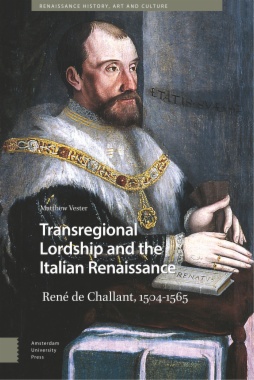René de Challant, whose holdings ranged from northwestern Italy to the Alps and over the mountains into what is today western Switzerland and eastern France, was an Italian and transregional dynast. The spatially dispersed kind of lordship that he practiced and his lifetime of service to the house of Savoy, especially in the context of the Italian Wars, show how the Sabaudian lands, neighboring Alpine states, and even regions further afield were tied to the history of the Italian Renaissance. Situating René de Challant on the edge of the Italian Renaissance helps us to understand noble kin relations, political networks, finances, and lordship with more precision. A spatially inflected analysis of René’s life brings to light several themes related to transregional lordship that have been obscured due to the traditional tendencies of Renaissance studies. It uncovers an ‘Italy’ whose boundaries extend not just into the Mediterranean, but into regions beyond the Alps.
- Cover
- Table of Contents
- Abbreviations
- Acknowledgments
- 1. On the edge of the Italian Renaissance
- The Italian Renaissance
- The Renaissance nobility
- Spatial analysis and mobility
- 2. René’s early career to 1536
- René’s early life
- René and Sabaudo-Swiss politics prior to 1536
- The lordship of Valangin and the counts of Neuchâtel
- Before the storm, 1531-1534
- 3. René’s growing influence during the war years, 1536-1553
- The invasions of 1536
- Valangin, the Reform, and relations with the Countess of Neuchâtel
- Political leadership and mobility during a time of uncertainty
- Struggling for the sovereignty of Valangin, 1542-1565
- 4. René and Duke Emanuel Filibert
- René and Emanuel Filibert
- Vercelli capture and efforts to get released
- The twilight of a career
- Family matters and René’s last years
- Historiographic perspectives of René’s life
- 5. Kinship and noble life
- Kin relations
- Relations with wives and children
- Nobles and domestic life
- Legal issues
- 6. The Challant political networks
- René’s network
- The regional scope of René’s ties
- René’s ecclesiastical network
- René’s key subordinates
- Mencia’s network
- Letters and information
- Relations with officials
- 7. Finance and brokerage
- Nobles and finance
- René as borrower and broker
- The financial situation inherited by René
- 1526-1536: Finances and Swiss negotiations
- Finance during the war years to 1545
- From the 1545 ‘restructuring’ to the second imprisonment
- The financial implications of ransom
- Financial recovery
- 8. Lordship
- Valangin during the war years
- Beaufremont
- René and the practice of lordship
- Fiefs and fiscality
- Sample castellany accounts: Châtillon, 1559-1560
- Administration of the fiefs
- 9. The embodiment of spatial politics
- About the author
- Index
- Maps and Tables
- Map 1: René’s transregional lands (mountainous areas shaded). Map by author.
- Map 2: Challant fiefs in the Valle d’Aosta. Map by author.
- Map 3: The Western Swiss area, with Valangin and its villages (mountainous areas shaded). Map by author.
- Table 1: A simplified genealogy of the Challant. Table by author.
- Table 2: Some of René’s fiefs and their castellans. Table by author.
- Figures
- Fig. 1: The decapitation of Saint Catherine, traditionally identified as Bianca Maria (detail of fresco by Bernardino Luini [ca. 1530] from Besozzi Chapel in church of San Maurizio al Monastero Maggiore, Milan). Source: Bernardino Luini e la pittura del R
- Fig. 2: The castle and bourg of Valangin (detail from eighteenth-century print [ca. 1786], original at Museum of the Castle of Valangin). Photograph by author.
- Fig. 3: Coin representing René as sovereign of Valangin (RENE · CO · CHALLAN · & · VALLENGIN · SUPR · D // & BARO · BOFFR · MONT · & · MAVILE · ET · D · CAST · & · VERRECY · C). Source: Georges Gallet, ‘Une Médaille de René, comte de Challant et seigneur
- Fig. 4: Countess Mencia, Philiberte, and Isabelle, detail from altarpiece dated 1547-1548, by an artist close to Jakob Seisenegger. Source: Archivi dell’Assessorato Turismo, Sport, Commercio, Agricoltura e Beni culturali della Regione autonoma Valle d’Aos
- Fig. 5: The courtyard of the castle of Issogne. Photograph by Attilio Locati; used with permission.
- Fig.6: Receipt, sealed with his blood, issued by René to his secretary Ducrêt for 120 florins (1558). Source: Archives de l’État de Neuchâtel, AS-K16.3; used with permission.

